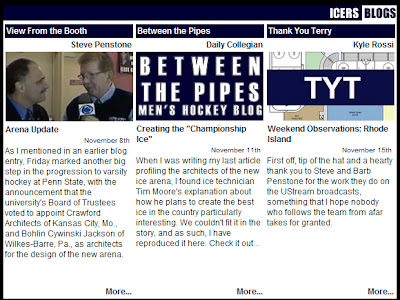Getting vibes once again that Sabres owner Tom Golisano is poking around for a prospective buyer for his Lake Erie stick carriers. Over the summer, Golisano had the locals all aflutter when he noted on local talk radio, “Nothing is written in concrete, but at this point I would say I’m probably going to be the owner of the Buffalo Sabres in five years, maybe 10 years.’’ The name that comes up in all NHL club sales talk is RIMM guru/hockey lover Jim Balsillie, who made himself no friends among NHL owners when he tried to pirate the Phoenix Coyotes away to Toronto’s outer suburbs. But the key name to keep in mind if this heats up: Terry Pegula. He’s the guy who forked over the $88 million gift for Penn State to build a rink and fund scholarships for Division 1 hockey. Pegula’s wife, Kim, is from suburban Buffalo, a good sign for the locals. No one ever wants to leave the Buff.Pro Hockey Talk had this comment on the Boston Globe story:
Seeing Terry Pegula’s name getting dropped in this is interesting. Pegula dropped a lot of money to essentially found Penn State University’s Division I varsity hockey program. Just tossing around $80 million to build two on-campus hockey rinks including a main building meant to watch college hockey in, and ensure that a major university can start their own program is no small amount of change. The Pegulas are big hockey fans and they’ve worked to get the Penn State deal done for almost five years. It’d be fascinating to see them potentially get involved in the Sabres and we’re sure that Paul Kelly of College Hockey Inc. would love to have such a big supporter of U.S. college hockey end up on the Board of Governors.It seems like all of the reaction out there is to the Globe piece, but I actually saw it first in the Edmonton Journal:
If Sabres’ owner Tom Golisano decides to sell and he’s made noises of that, Jim Balsillie and his kazillions from BlackBerry might be in the picture but there’s also a fellow named Terry Pegula who just gave $88 million to Penn State to build a rink for NCAA Division 1 play and fund scholarships there. His wife Kim is from suburban Buffalo. Pegula’s made his money in natural gas business.Balsillie's name always comes up when a team is for sale, but if the Penguins, Predators and Coyotes situations gave any indication, the NHL will use any and all measures available to stop Balsillie from buying the Sabres just so he can move them 70 miles up the road to Hamilton, or maybe 30 miles past that to the Greater Toronto Area. Which leaves Pegula as the only viable candidate being name-dropped for the sale that has yet to be made public, if it even happens.
I'm hopeful it plays out, if only because it would give this nomadic fan who has yet to pick a long-lasting new favorite NHL team since the demise of the Whalers a solid reason to jump on Buffalo.
UPDATE 1, 9:14 a.m. 11/30: The Buffalo News finally jumped on this train. I wouldn't go through the trouble of editing my post just to copy/paste a similar-sounding comment - but the News makes it sound like things are heating up:
Sources confirmed Monday that his interest picked up in recent weeks, although an agreement did not appear imminent. Any sale could take several months, assuming he doesn't lose interest or have negotiations fall apart.UPDATE 2, 10:07 a.m. 11/30: Pegula has signed a letter of intent to buy the Sabres for $150 million, according to Ken Campbell of The Hockey News.
















